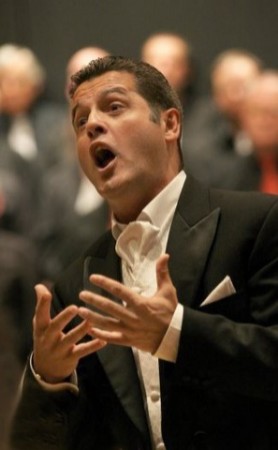
tenorcarminaburana.com
♦ Joaquín Asiáin · Tenor ♦

Joaquín Asiáin stammer fra Nordspanien. Han blev uddannet på konservatoriet i Madrid og fortsatte studierne pa Staatliche Hochshule für Musik und Darstellende Kunst i Stuttgart (og har i ovrigt ogsa studeret sociologi på universitetet i Madrid). Jeg modtog lærdomme fremtrædende personligheder lyriske, Alfredo Kraus, Thomas Quastoff, Aldo Baldin, Marimi del Pozo, William Matteuzzi …Joaquín Asiáin har optradt med talrige orkestre, herunter Bamberger Symphoniker, Camerata Bregenz, Hamburger Symphoniker, Staatsphilharmonie Nürnberg, Berliner Symphoniker, Borusan Istanbul Philharmonic Orchestra, Orquesta de R.T.V.E, Orquesta Sinfónica de Madrid og Sonderjyllnads Symfoniorekster.Blandt hans roller er Ernesto i Don Pasquale, Ferrnado i Così fan tutte, Svanen i Carmina Burana , Petite Messe Solennelle, Stabat Mater i Messa di Gloria (G. Rossini) og Don Basilio i Figaros bryllup. Han har bl.a optrádt i Festspielhaus Bregenz, XIII Festival Internacional de las Artes de Costa Rica, VIII Nordhessen Kultur Sommerfestival, Tonhalle Zürich, Teatro Nacional de Costa Rica, XXVII Temporada d’Opera de Palma de Mallorca, XI, XIII Festival Internacional MusicaMallorca XXXI, XXXII International Music Festival Istanbul, Auditorio Nacional de Mexico, Laieszhalle Hamburg, Großes Festspielhaus Salzburg og Berliner Philharmonie.
Joaquín Asiáin er, hvad der er kendt som „Tenore di grazia“, ifølge hvilket der opnås usædvanligt høje toner.
♦The Swan ♦
The figure of the Swan (Der Schwan) in the Carmina Burana is of special relevance.
Carl Orff composed a very sharp aria for tenor with extremely notes … 3 x c5, 3 x d5 and 9 X Si4 … all composed of three strophes. Orff thought and wrote the aria for a tenor (not a countertenor who sings in falsetto). In 1937 (year of composition of the work) the figure of the countertenor in the world opera scene had not yet resurfaced. It was the English countertenor Alfred Deller who rescued in the 1940s (later to the composition of the Carmina Burana).
♦ Video – You Tube ♦
https://www.youtube.com/watch?v=kUR4nc_ucuk
♦ Some reviews ♦
775 City jubilee STADTHALLE KLEVE
… and tenor Joaquín Asiáin shone as a „fried“ swan with full voice in the very highest tessitura. A pleasure!
RP-Online – 13.06.2017
WÜRTTEMBERGIC PHILHARMONIC
Asiáin made from the lamento of the fried swan in the pan a vocal and actorically convincing piece of cabinet.
By Christoph B. Ströhle – Reutlinger General Anzeiger – 10.3.2015
STADTHALLE HEIDELBERG
The spanish Tenor Joaquín Asiáin fascinated in his role as a fried swan. He did not use his hands to keep the notes, but with powerful gestures underlined and illustrated the text.
By Wenzel Hübner – Rhein Neckar Newspaper – 31.07.2013
GREIZ-VOGTLAND PHILHARMONIC
The soloists … and Joaquín Asiáin did not have an insignificant part. Above all, the latter struck with his unusual tenor, he can achieve incredibly high tones.
By Katja Grieser – East Thuringian newspaper – 22.06.2009
COLOGNE PHILHARMONIC HALL
Tenor Joaquín Asiáin gave the fried swan so convincingly that one could almost smell the crispy ribs.
Porz – Online.de – 26.11.2008
NUEVO LEON THEATER – MONTERREY (MEXICO)
The Spanish tenore di grazia Joaquín Asiáin has a not very frequently heard voice in Monterrey. Its timbre of light texture and unbelievable ease for the high tessitura combined with an impressive scenic capacity, is considered a treat for the connoisseur.
R.Tischavsky-Millenium N.L – Monterrey -10.03.2007
♦